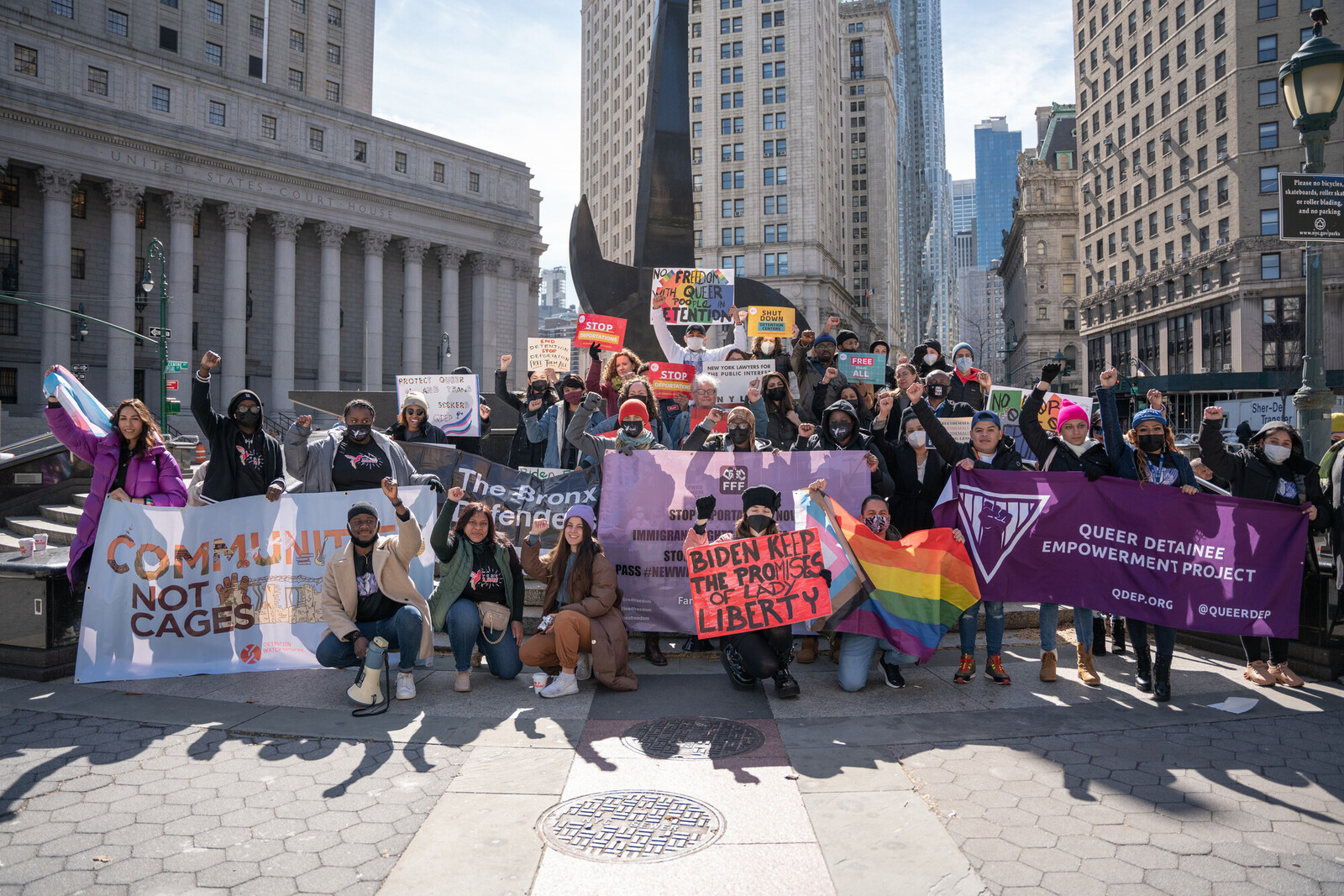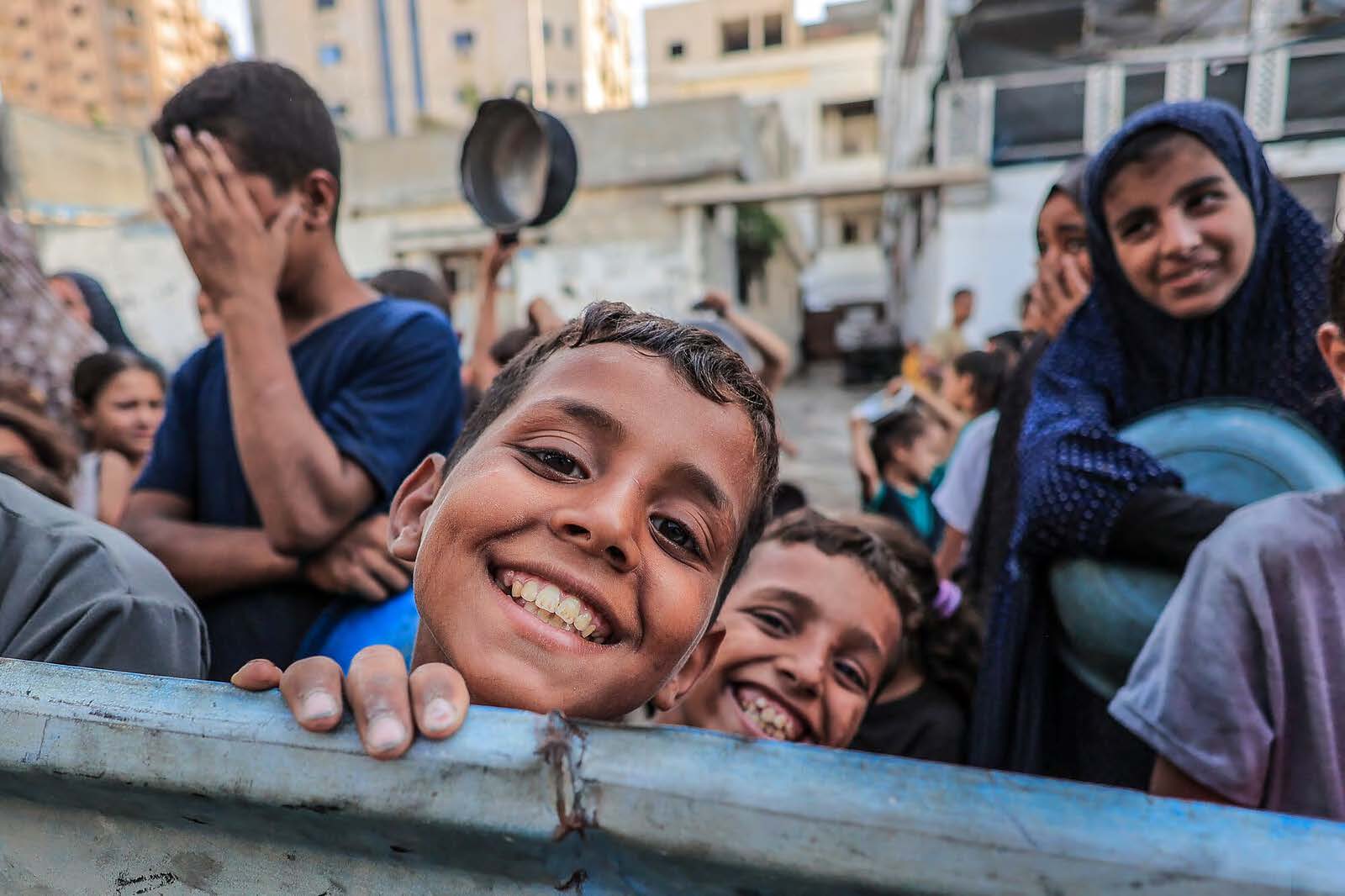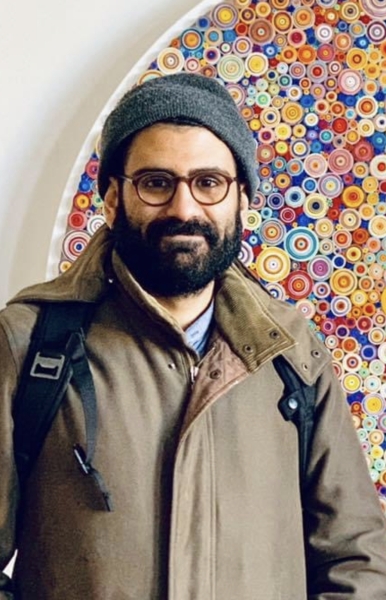
Communities Not Cages action in New York City in March 2022. Cindy Trinh / AFSC
June 28 marks the 53rd anniversary of the Stonewall uprising in response to pervasive police violence targeting queer and trans communities. Five decades later, LGBTQ+ youth and adults are disproportionately overrepresented at every stage of the American criminal punishment system.
For the past year, I have been conducting research around the needs of LGBTQ+ people who are incarcerated and detained, developing a toolkit of resources for AFSC and ally organizations. Here are some of the key takeaways from this project.
1. LGBTQ+ people and communities are uniquely vulnerable to the harms of the criminal punishment system.
Like any institutionalized system of harm, the extent to which LGBTQ+ people are affected by the American penal system corresponds to the kinds of material insecurities they faced early in their lives. A 2016 survey of youth in juvenile detention facilities found that lesbian, gay, bisexual, transgender, questioning, and gender nonconforming youth are overrepresented in the welfare and foster care system—at least five times more likely to be placed in a group or foster home, compared with straight and gender conforming youth. In escaping abuse and isolation at home, LGBTQ+ youth often find themselves in deeply precarious contexts, where their options for survival are extremely restricted.
Moreover, being branded by the punishment system in the United States has enduring and life-altering consequences. Individuals that come into contact with this system in their youth are likely to re-enter as adults. An analysis of data from the National Survey on Drug Use and Health (NSDUH) suggests that gay, lesbian, and bisexual adults are 2.25 times more likely to be arrested than straight adults, which has resulted in an overrepresentation of LGBTQ+ adults in prisons and jails at a rate three times that of the total adult population. Across prisons in the United States, 5.5% of men in prison identify as gay or bisexual; 33.3% of women in prison identify as lesbian or bisexual; and 24.6% of women in county and municipal jails identify as lesbian or bisexual.
While national research on harms of policing in trans communities is sparse, other research clearly indicates that police are violently biased against trans people, especially the Black trans community. According to the National Center for Transgender Equality, one in five trans individuals have been harassed by the police, including 38% of Black trans individuals.
Lastly, government data from 2018 has shown that LGBTQ+ people held at federal detention centers are 97% more likely to be sexually assaulted than other detainees. This is a staggering figure, especially considering that these numbers are based on data collected by U.S. Immigration and Customs Enforcement (ICE). In other words, the actual situation is likely far worse than these figures indicate.

2. LGBTQ+ experiences and identities are not monolithic.
LGBTQ+ encounters with law enforcement are not monolithic and should not be studied as such. For instance, what bisexual and lesbian women experience in the criminal justice system is markedly different from the challenges faced by gay men, which in turn have to be distinguished from the abuse and inhumane treatment of trans women of color. This is not to say that one group has a monopoly on unequal and unjust treatment. Rather, it’s to emphasize that the harms of the penal system are multi-layered and have to be intersectionally analyzed.
The criminologist and theorist Beth Richie contends that challenging mainstream discourse about crime and punishment requires, as a starting point, that we “interrogate the ways that gender, sexuality, race, and class collide with harsh penal policy and law enforcement.” This is a critical insight of any intersectional analysis. Like all identities, queer identities are multifaceted and heterogeneously constructed. There is no standalone generic experience that could accommodate the varieties of queer identities that emerge at the intersections of race, gender, class, religion, immigration status, ability, and so on.
3. It’s important to follow, support, and amplify organizations that are advocating and organizing around LGBTQ+ issues within an abolitionist framework.
Here is a resource list of organizations working to address LGBTQ+ needs and advocacy. Some of the organizations included in this guide are:
Black and Pink: A prison abolitionist organization dedicated to abolishing the criminal punishment system and liberating LGBTQ+ people and people living with HIV/AIDS who are affected by that system.
Abolitionist Law Center: Abolitionist Law Center litigates on behalf of people whose human rights have been violated in prison, educates the general public about the evils of mass incarceration, and works to develop a mass movement against the American punishment system by building alliances and nurturing solidarity across social divisions.
LGBTQ Freedom Fund: Pays bail to secure the release of individuals in immigration facilities. They also work to address the disproportionately high rate and harm of jailing on LGBTQ+ individuals — a tangle of discrimination and poverty fuels this problem.
I invite the readers to explore these resources further, and to engage with the opportunities for responding to the needs of LGBTQ+ detained and incarcerated communities. The challenges that such communities face are multitudinous and require coordinated efforts to redress. Having a lay of the land is an important first step to building networks of solidarity that could adequately respond to those needs.

4. Conclusion
The policing and regulation of gender and sexual expression is core to the founding logic of the United States. The threads of this logic run from the ethno-European colonization of Indigenous land all the way through to present day assault on the rights of LGBTQ+ communities. Legislative advocacy plays an important part in challenging the legally institutionalized harms of this system. But such efforts have to be coupled with grassroots activism that challenges the cultural perceptions of crime and punishment.
Moreover, what does it mean to be a prison abolitionist? This question is often answered in the abstract, stating a blanket opposition to jails and prisons. But a robust commitment to an abolitionist worldview requires that we engage with the particular needs of different communities across different contexts, acknowledging that such forms of engagement vary from place to place, yet intersect and interconnect.
For the purposes of this analysis, it should be emphasized that every key issue that informs domestic and international advocacy is a queer issue. Healing justice is a queer issue. Peacebuilding is a queer issue. Humane migration is a queer issue. Just economies is a queer issue. As such, we have to collaborate, communicate, and build across networks of local and national advocacy, ensuring that we are responding to the concrete and interlocking needs of various communities impacted by the carceral system.
See further:
AFSC's North Star, a vision for community safety beyond prisons and policing. It outlines 7 guideposts on the path toward abolition. Link here.
Instead of trying to “fix” the systems of incarceration we have, it is time for us to build something new. Link here.

